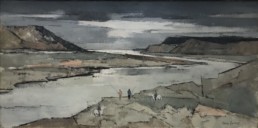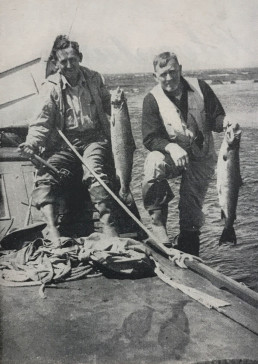Salmon Fishing in Iceland
Renowned painter Paul Sample may be recognized today for his depictions of rural landscapes, but this artist was also a lifelong birder, musician, teacher, and angler.
During the mid-twentieth century, Sample frequently fished Lake Willoughby and the nearby waters of Québec while visiting his in-laws in northern Vermont. Sample was known to tie his own flies and experiment with adaptations to existing patterns. The Paul Sample Fly, named by a friend, was one of these creations. Designed for catching large trout, salmon, and bass, the fly is tied on a long-shanked, 2x or 3x, no. 6, 8, or 10 hook. A small cork cylinder—rounded on each end with a razor blade and smoothed with sandpaper—is slit lengthwise and secured around the hook with cement and silk thread. Red or gray squirrel tail, polar bear, or bucktail is used for the wing, with the hackle and tail tied to match. Sample’s fly is an adaptation of a pattern he picked up from a guide in New Brunswick on the Tobique River. Close friend Sidney Hayward documented the fly in action during one of his numerous fishing trips with Sample in the article “Labrador Adventure,” published in the July 1951 issue of Field & Stream.
Sample always carried his watercolors and a sketchbook while fishing, ready to stop and record people and places encountered along the way. Salmon Fishing in Iceland was probably created in the artist’s studio, using the studies made on his travels as a reference. Sample’s use of bird’s-eye view and abstracted forms offer an objective vision of the rocky and elemental Icelandic landscape. With honesty, Sample draws attention to the vast terrain through linear brushstrokes and a cool palette. Although storm clouds remain at bay, the landscape is not oppressive. For the anglers and their guides at the center of the scene, this is just one stop among many on their adventure.
Paul Sample (American, 1896–1974)
Salmon Fishing in Iceland, ca. 1952
oil on canvas
2019.051.116



